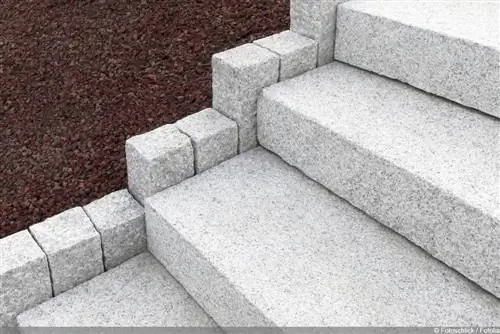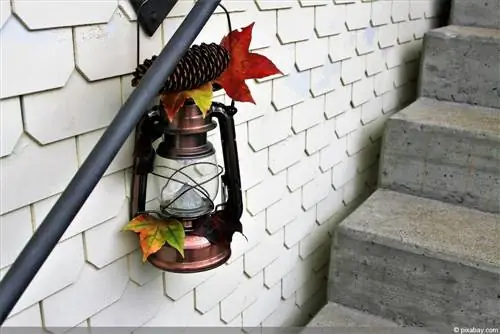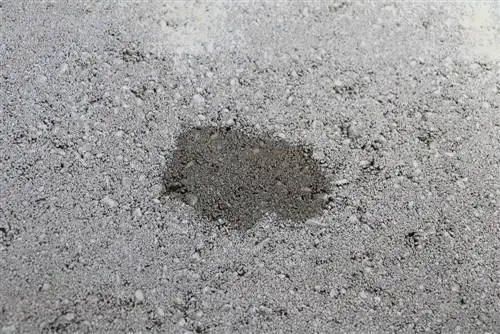- Author admin [email protected].
- Public 2023-12-17 03:39.
- Last modified 2025-01-24 12:45.
A natural stone staircase gives your home or outdoor area a natural look. They are resilient, very durable and therefore a long-term investment. In addition, thanks to the numerous different types of stone, they can be designed very differently and adapted to the interior. However, prices can also vary significantly. Tips for saving costs and choosing can be found here.
Features, advantages and disadvantages
The natural stone staircase is very durable and resilient if the material is selected appropriately. It fits harmoniously into the garden and gives the interior a natural accent. In addition, the stone stairs can easily be made non-slip. To change the look, the steps can easily be covered with a pad, at least indoors.
Disadvantage
A potential disadvantage, however, is that acquisition and material costs are comparatively high. In addition, repairs - for example if a stone slab is cracked - are very difficult to carry out.
Structure and types
There are three different types of stairs when it comes to construction. Firstly, the support bolt staircase. In this case, the individual steps are connected to the wall on one side. The spaces between the steps create a more open and airy look.
The second variant is block-step stairs. They are more compact in appearance and comparatively easy to install. The third and relatively widespread type of stone stairs are prefabricated concrete stairs, which are provided with a natural stone base. So the base of concrete steps is covered with stone tiles.
Total costs: factors and tips
The total cost of a stone staircase is made up of various factors. These include:
- Size of the stairs or number of steps
- Stone type, origin and processing
- Dimensions of the stones
- Type of stairs
- railing
- Planning, installation and transport
Example
The following example can make the breakdown of the individual items clear:
- For an interior staircase with 15 steps, a prefabricated concrete staircase is used as the basis.
- The railing is made of stainless steel.
- The steps themselves are covered with a natural stone covering.
- The basis including planning and installation costs 1,500 to 2,000 euros.
- Another 1,500 to 2,000 euros should be included for the stone overlay
- An additional 1,000 euros should be included for railings, transport and processing of the underside of the stairs.
A stone staircase can be installed between two floors for around 4,000 to 5,000 euros.
Tips

However, in order to achieve the lowest possible price, the following tips should be observed:
-
Standard dimensions are cheaper:
Stone slabs in standard dimensions are significantly more cost-effective than custom-made ones. When planning the staircase, you should therefore use standard dimensions if possible.
-
Species and origin are crucial:
It's not just the type of stone that determines the price, but also where the stones were mined and how long the transport takes. the more complex the extraction and the longer the transport, the more expensive the material is.
-
Pay attention to the weight:
High-weight elements not only increase transport costs, but also the effort involved in assembly.
-
Compare prices
The material and transport costs can vary significantly. A price comparison between the providers is definitely worth it.
Prices for types of stone
The total costs consist largely of the stones or stone slabs. These can be quite different depending on the type of stone. We have therefore put together an overview of the most popular types of stone for your orientation:
- Gneiss per square meter 25 to 60 euros
- Granite 30 to 90 euros per square meter
- Marble per square meter from 50 to 150 euros (but also several hundred up to 1,000 euros possible)
- Slate 30 to 90 euros per square meter
- Travertine per square meter 40 to 80 euros
- Quartz composite stone from 10 to 40 euros per square meter
- Quartz stone per square meter 20 to 40 euros
Tip:
Be careful with particularly inexpensive offers. Especially when it comes to stone mined in Asia, there is a risk that the stone was extracted using blasting. As a result, the stone slabs may initially have inconspicuous hairline cracks, which can lead to damage to the stairs even with minimal force.






